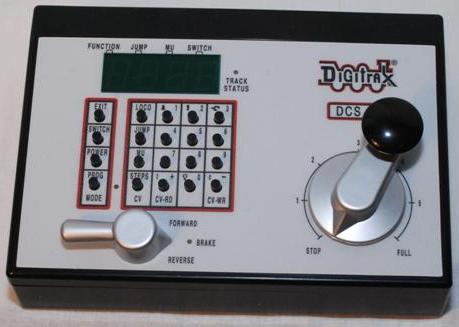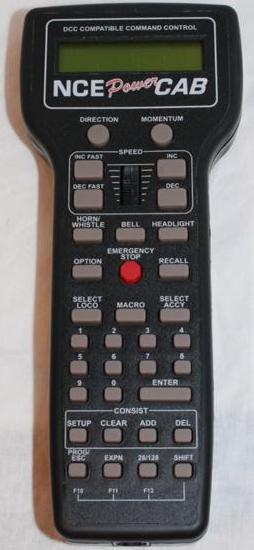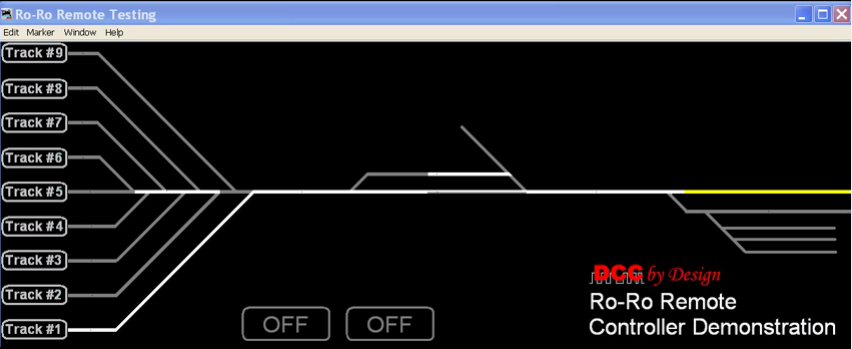Welcome to the World of DCC!
Digital Command Control (DCC) allows model railroaders to directly control their train not just power blocks. While this is a seemingly simple concept, the opportunities opened up the modeler are nearly infinite.
This article and the others on this site provide basic information to educate DCC consumers. DCC by Design offers the service of designing a DCC system for you. As part of our Design Services we will work with you to examine your needs, address the issues below and many, many more. Then we convert your preferences, layout design, and budget into a complete DCC system.
We offer this free information as a small sample of how we can help you with our Design Services. Drop us note so we can discuss with you improvements for your current or design for your next layout.
Getting Started
Many articles have been written about which DCC system is better than another. While there are some systems that are not as good, there is no best system. There are three "top tier" manufacturers, and which of these systems is best is a personal preference, based on your needs and budgets. To help choose which system is best for you, we offer these questions for prospective clients to ponder:
- Are you in a train club? If so, what DCC system does the club use?
- If you are not a club member, then what system does your local hobby shop or other local “expert” use?
- How big is your current layout (in terms of track length, number of turnouts, and operating locomotives)? What about the next layout? Will there be one after that?
- How many operators will your layout require?
- How do you plan to control turnouts? Do you plan to have dispatchers, tower operators, crew operated, or another variation?
- Do you plan to build working signal system?
- In the past few years sound has become a very popular option. Do you plan to use sound equipped locomotives? Do you plan to take advantage of other future DCC improvements?
- Have you tried the system you are thinking about buying? Do you find the throttle intuitive or easy to use?
- What is your budget?
- Have you already received some pieces of a system as a gift?
From the above questions, you should be able to gauge what systems might be front runners, based on the support of that system in your area. Also, you should have a pretty good idea of what features are most important to you.
Because technology changes very rapidly (just look at sound locomotives) I suggest that the reader buy a system with a clear upgrade path. The current offerings from Digitrax,Lenz, and NCE have such a clear upgrade path. Unfortunately, the current offerings forMRC, and Bachmann, do not appear to offer a clear upgrade path. It is worth noting that Digitrax, Lenz, and NCE were formed specifically to develop DCC systems; DCC equipment are their only products. MRC and Bachmann on the other hand, are much more general model train and hobby companies.
Atlas' system is the hybrid, it is actually built by Lenz, and can connect with other Lenz equipment.
What's in Starter set?
Typically a starter set will include the following components
1. Throttle - Dials and buttons used to control a train.
2. Encoder - Electronic box which converts input from throttle into commands for the locomotives. Typically combined with Booster in a Command Station.
3. Booster - Combines the single from the encoder with the DC power for the layout. Typically combined with encoder in a command station.
4. Throttle Jack - Many systems provide hand-held throttles separate from the command station, thus a jack and cables are provided to plug the throttle into the command station.
5. Power supply - Most, but not all systems provide a transformer as the DCC power supply. Other systems rely on using your old DC power pack to provide power.
Selecting a Starter Set
All of the major three vendors (Digitrax, Lenz, and NCE) have a basic starter system and one or two more advanced starter systems. For all the vendors, the starter set represents a significant discount over buying the same components a la carte.
Key Features
Separate Programming Track - I strongly encourage all buyers to get a system that supports a separate programming track. Many mistakes have been made (like reprogramming all locomotives) that could be avoided by having this feature.
Read Capability - Again, I strongly encourage all buyers to get a system that supports read back capability. It is the next logical step from a separate programming track. When trying to figure out why a locomotive it is helpful to read what is programmed into the locomotive, not just guess.
Computer Interface - Although I don't encourage most buyers to get the computer interface at first, I encourage all to buy a system with this option. Many modelers I've met have little trouble programming their locomotives once they add this feature. I recommend the JMRI Decorder Pro Software for this use. To see what else can be done with a computer interface, go to our page on JMRI Services.
|
|
|
| Digitrax Zephyr Starter Set | NCE Pro Cab Throttle |
Understanding the Comparison Tables
Many vendors of DCC systems provide comparison tables for different DCC systems, one example is this one from Tony’s Train Exchange. Such a chart seems like great information, but what do you really do with it? The following list outlines the key considerations in order of what to look for:
- Number of functions – The control unit should support at least 12 functions in order to control sound equipped locomotives and provide for future enhancements. Some units, like the Digitrax Zephyr, are capable of controlling 12 functions, if provided with a throttle (or cab) that has buttons for all 12 functions. This method is sufficient for future upgrade, but might not be enough for use of sound locomotives today.
- Number of Locomotives – Layout Specific
This feature determines how many unique locomotives can be run at the same. While 10 might seem like a pretty big number, you need to consider whether you are going to run diesels MU’ed. In other words if you plan to have 3 diesels heading every train, then 10 might be too low a limit. Alternatively, if those same three diesels always run together, then they can be programmed with the same address and appear as one locomotive to the DCC system. - Read/Write Programming – YES
This feature greatly simplifies programming locomotives. You can read the values from the locomotive, make the desired changes, and read the new values to verify the changes. It is much easier than programming a locomotive in the “dark” not knowing what the original or new values are. - Power (amps) – Layout and scale specific, see below
- Radio Control Option – Nice to have
This is a great feature if it is in your budget. It is very helpful, even on small layouts to be able to control the train when standing right next to it, without worrying about plugging in a throttle. However, this feature can be added latter. I would not buy a system that does not support adding a wireless throttle at a later date. - Computer Interface – Nice to have
A personal computer such as an IBM or Mac is NOT required to run a DCC layout. However, sometimes it can make it easier. As computers become more common place in homes, old computers to help with programming decoders and dispatcher operations will also become more common. Also, many DCC sound systems now feature downloadable sounds. This requires a computer and a command station that can interface with the computer. Therefore, I suggest buying only starter systems that can be connected to a computer, even if you don’t buy the interface right away.
There are other items, such as those listed below that you can pretty much ignore:
- Number of throttles (or cabs) – The determines how many people can be operating trains on the layout at one time. I doubt that it is real limitation. The smallest number I’ve seen is 10 for a basic system. If your layout is big enough to sustain 10 operators, then you’ll likely be getting an advanced system anyway.
- Decoder Address Types – Two digit or Four Digit – Almost every system made now supports four digit address. This allow the locomotive number (typically four digits, at least in the US) to be used as the DCC address. If the system is one of the few that does not support four digit addresses, then skip it. It is too far out of date and will be missing other features as well.
- Ops mode Programming – Allows you to reprogram some CVs while the locomotive is operating. I never use this feature because of the potential to cause problems, specifically reprogramming all of the locomotives on the layout, not just one.
- Direct mode Programming – Again, I have never used this feature.
- Stationary Decoder Operation – All units should have this feature.
- Speed controls – Far more important is how comfortable you are with the throttle, than any statistics associated with it.
- NMRA Conformance – There are some challenges with the paperwork associated with obtaining conformance by the manufacturer. Thus there are systems that meet it technically, but are not officially blessed. I wouldn’t let this make or break the deal.
Determining your power needs
The last big challenge in buying your starter system is determining how much power you need for the starter set. Most vendors supply 3.5 amp, 5 amp, or 8-10 amp choices. So for this article we will focus on selecting which of the three you need. A later article will focus on designing power districts and power needs in much more detail.
I recommend buying a unit with 5 amp power supply, unless you are operating a very small HO layout (only two engines or three locomotives) or a small N scale set (about five locomotives). Here is why:
One problem with the big units (8-10 amps) is that the can melt the shell of locomotives. When a short develops on the layout, such as from a locomotive derailing in a turnout, the full current must pass through the offending locomotive. This creates a build up of heat. A smaller power unit, such as five amp units, will build up heat at less than half the rate of the big units, thus it will take twice as long to create enough heat to melt the shell. Therefore, the big units need special devices to manage their power. The installation of these devices is not difficult; but it is an added step that must be mastered before you can enjoy your new starter system. Therefore, it is simpler to buy a small unit and focus on learning DCC.
All motors draw more current when they start then they do once running. Therefore, you need to select the power based on starting current for your locomotives. The following table provides some guidance on starting current:
| Type | Motor | Sound Unit | Lights | Total |
| N Scale New – Basic | 0.25 amps | none | 0.125 amps each | 0.50 amps |
| HO Scale New – Basic | 0.50 amps | none | 0.125 amps each | 0.75 amps |
| HO Scale Old – Basic | 1.00 amps | none | 0.250 amps each | 1.50 amps |
| HO Scale – Sound | 0.50 amps | 0.5 amps | 0.125 amps each | 1.50 amps |
A 3.5 amp system will power two HO units with sound, or three to four units without sound, depending on the locomotives. In N scale, the same system will power about five locomotives, depending on their age.





 Today we posted information about our
Today we posted information about our 

